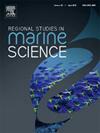根据经常观测到的海岸剖面数据分析海龟上岸行为--日本恩州海岸案例研究
IF 2.1
4区 环境科学与生态学
Q3 ECOLOGY
引用次数: 0
摘要
本研究分析了日本远州海岸面向太平洋的 10 公里沙滩上的海龟登陆行为。分析数据是由手持式全球导航卫星系统设备记录的海龟在 5 月至 9 月(2011-2016 年)期间的登陆位置和爬行轨迹,同时记录产卵或不产卵活动,并辅以每周在四个地点进行的跨岸海滩剖面调查、卫星图像和其他地理数据。开始时,我们将海滩上的着陆位置可视化,以确定海滩上的局部集中点。随后,我们估算了上岸时产卵和不产卵位置与水线的距离,并通过时间高程变化标准偏差评估了海滩的稳定性。研究发现,首选产卵位置是距水线 40-70 米、潮间带以上、裸沙上,标准偏差为 0.1-0.6 米。这项研究还强调了海滩基础设施对海龟产卵失败的影响,以及巨浪高度对海龟登陆的影响。本文章由计算机程序翻译,如有差异,请以英文原文为准。
Analyses of sea turtle landing behavior based on frequently observed coastal profile data - A case study in Enshu Coast, Japan
This study analyses sea turtle landing behavior along a 10 km sandy beach on the Enshu Coast, Japan, facing the Pacific Ocean. Data for the analysis are sea turtles' landing positions and crawl tracks recorded by a handheld GNSS device from May to September (2011–2016), noting spawning or no-spawning activity simultaneously, supplemented by weekly cross-shore beach profiles surveyed at four locations, satellite images, and other geographical data. At the onset, landing positions on the beach are visualized to determine local concentrations along the beach. Subsequently, we estimate the distance of spawning and no-spawning positions from the waterline during landing and evaluate beach stability through the temporal elevation change standard deviation. The study found that preferred spawning locations are 40–70 m from the waterline, above the intertidal zone, on bare sand, with a standard deviation of 0.1–0.6 m. This study also highlights the impact of beach infrastructure on sea turtle spawning failures and the influence of significant wave height on sea turtle landing.
求助全文
通过发布文献求助,成功后即可免费获取论文全文。
去求助
来源期刊

Regional Studies in Marine Science
Agricultural and Biological Sciences-Ecology, Evolution, Behavior and Systematics
CiteScore
3.90
自引率
4.80%
发文量
336
审稿时长
69 days
期刊介绍:
REGIONAL STUDIES IN MARINE SCIENCE will publish scientifically sound papers on regional aspects of maritime and marine resources in estuaries, coastal zones, continental shelf, the seas and oceans.
 求助内容:
求助内容: 应助结果提醒方式:
应助结果提醒方式:


